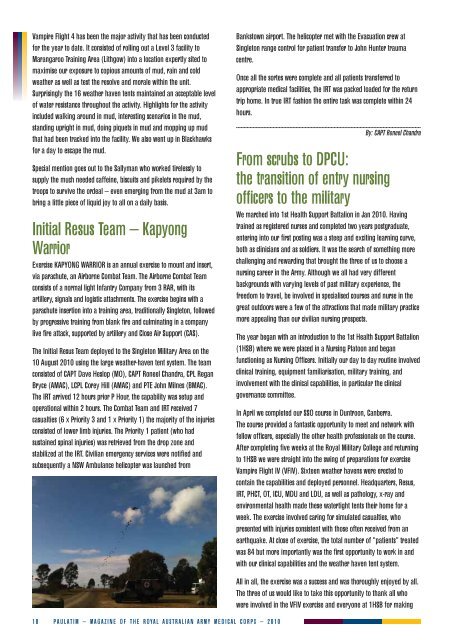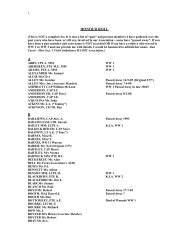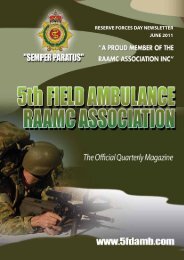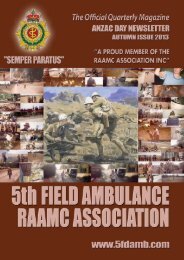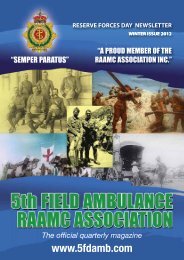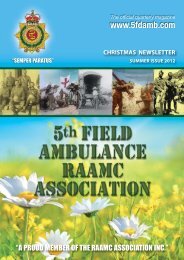2010 Paulatim Magazine - RAAMC Association
2010 Paulatim Magazine - RAAMC Association
2010 Paulatim Magazine - RAAMC Association
Create successful ePaper yourself
Turn your PDF publications into a flip-book with our unique Google optimized e-Paper software.
Vampire Flight 4 has been the major activity that has been conducted<br />
for the year to date. It consisted of rolling out a Level 3 facility to<br />
Marangaroo Training Area (Lithgow) into a location expertly sited to<br />
maximise our exposure to copious amounts of mud, rain and cold<br />
weather as well as test the resolve and morale within the unit.<br />
Surprisingly the 16 weather haven tents maintained an acceptable level<br />
of water resistance throughout the activity. Highlights for the activity<br />
included walking around in mud, interesting scenarios in the mud,<br />
standing upright in mud, doing piquets in mud and mopping up mud<br />
that had been tracked into the facility. We also went up in Blackhawks<br />
for a day to escape the mud.<br />
Special mention goes out to the Sallyman who worked tirelessly to<br />
supply the much needed caffeine, biscuits and pikelets required by the<br />
troops to survive the ordeal – even emerging from the mud at 3am to<br />
bring a little piece of liquid joy to all on a daily basis.<br />
Initial Resus Team – Kapyong<br />
Warrior<br />
Exercise KAPYONG WARRIOR is an annual exercise to mount and insert,<br />
via parachute, an Airborne Combat Team. The Airborne Combat Team<br />
consists of a normal light Infantry Company from 3 RAR, with its<br />
artillery, signals and logistic attachments. The exercise begins with a<br />
parachute insertion into a training area, traditionally Singleton, followed<br />
by progressive training from blank fire and culminating in a company<br />
live fire attack, supported by artillery and Close Air Support (CAS).<br />
The Initial Resus Team deployed to the Singleton Military Area on the<br />
10 August <strong>2010</strong> using the large weather-haven tent system. The team<br />
consisted of CAPT Dave Heslop (MO), CAPT Roneel Chandra, CPL Regan<br />
Bryce (AMAC), LCPL Corey Hill (AMAC) and PTE John Milnes (BMAC).<br />
The IRT arrived 12 hours prior P Hour, the capability was setup and<br />
operational within 2 hours. The Combat Team and IRT received 7<br />
casualties (6 x Priority 3 and 1 x Priority 1) the majority of the injuries<br />
consisted of lower limb injuries. The Priority 1 patient (who had<br />
sustained spinal injuries) was retrieved from the drop zone and<br />
stabilized at the IRT. Civilian emergency services were notified and<br />
subsequently a NSW Ambulance helicopter was launched from<br />
Bankstown airport. The helicopter met with the Evacuation crew at<br />
Singleton range control for patient transfer to John Hunter trauma<br />
centre.<br />
Once all the sortes were complete and all patients transferred to<br />
appropriate medical facilities, the IRT was packed loaded for the return<br />
trip home. In true IRT fashion the entire task was complete within 24<br />
hours.<br />
By: CAPT Roneel Chandra<br />
From scrubs to DPCU:<br />
the transition of entry nursing<br />
officers to the military<br />
We marched into 1st Health Support Battalion in Jan <strong>2010</strong>. Having<br />
trained as registered nurses and completed two years postgraduate,<br />
entering into our first posting was a steep and exciting learning curve,<br />
both as clinicians and as soldiers. It was the search of something more<br />
challenging and rewarding that brought the three of us to choose a<br />
nursing career in the Army. Although we all had very different<br />
backgrounds with varying levels of past military experience, the<br />
freedom to travel, be involved in specialised courses and nurse in the<br />
great outdoors were a few of the attractions that made military practice<br />
more appealing than our civilian nursing prospects.<br />
The year began with an introduction to the 1st Health Support Battalion<br />
(1HSB) where we were placed in a Nursing Platoon and began<br />
functioning as Nursing Officers. Initially our day to day routine involved<br />
clinical training, equipment familiarisation, military training, and<br />
involvement with the clinical capabilities, in particular the clinical<br />
governance committee.<br />
In April we completed our SSO course in Duntroon, Canberra.<br />
The course provided a fantastic opportunity to meet and network with<br />
fellow officers, especially the other health professionals on the course.<br />
After completing five weeks at the Royal Military College and returning<br />
to 1HSB we were straight into the swing of preparations for exercise<br />
Vampire Flight IV (VFIV). Sixteen weather havens were erected to<br />
contain the capabilities and deployed personnel. Headquarters, Resus,<br />
IRT, PHCT, OT, ICU, MDU and LDU, as well as pathology, x-ray and<br />
environmental health made these watertight tents their home for a<br />
week. The exercise involved caring for simulated casualties, who<br />
presented with injuries consistent with those often received from an<br />
earthquake. At close of exercise, the total number of “patients” treated<br />
was 84 but more importantly was the first opportunity to work in and<br />
with our clinical capabilities and the weather haven tent system.<br />
1 8 P A U L AT I M – M A GAZINE O F T HE R OYA L A U S T R A L I A N A R M Y M E DICAL C O R P S – 2 0 1 0<br />
All in all, the exercise was a success and was thoroughly enjoyed by all.<br />
The three of us would like to take this opportunity to thank all who<br />
were involved in the VFIV exercise and everyone at 1HSB for making


